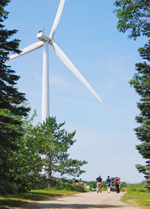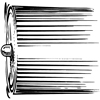|
|
|
Windustry E-Newsletter
March 2010
|
|
Wind Turbine Syndrome: Myths and Facts
Wind energy enjoys wide public support--91 percent of
Americans are in favor of developing more wind and solar energy
sources, according to a ABC News/Washington Post Poll in August 2009.
However, a small percentage of detractors have raised concerns that the
sounds emitted from wind turbines cause adverse health effects.

"Wind Turbine Syndrome" is not a medical classification, but a
collection of symptoms from a small anecdotal sampling by Dr. Nina
Pierpont, who describes herself as "fundamentally a country doctor."
While there is no medical research that substantiates her claims about
adverse health effects caused by wind turbines, opponents of wind
energy projects cite her writings as scientific fact.
Windustry
hosted a webinar "Wind Turbine Syndrome: Myths and Facts" working with
the Great Lakes Regional Wind Energy Institute with support from the
National Renewable Energy Laboratory on February 11, 2010. The webinar
provided a discussion of the myths and facts behind wind turbine
syndrome and how scientific research is used to both support and deny
the claims made.
Presenters for Wind Turbine Syndrome: Myths and Facts included:
- W. David Colby, M.D.:
Chatham-Kent Medical Officer of Health (Acting); Associate Professor,
Schulich School of Medicine & Dentistry, University of Western
Ontario
- Geoff Leventhall, Ph.D.: Consultant in Noise Vibration and Acoustics, UK
A
webinar recording is available on the Windustry web site, along with
the slides and the report "Wind Turbine Sound and Health Effects: An
Expert Panel Review," prepared by a panel of doctors, audiologists, and
acoustical professionals sponsored by the American Wind Energy
Association and the Canadian Wind Energy Association.
Get more information and play the webinar
|
 Celebrating Women's History Month! Celebrating Women's History Month!
Executive Director Lisa Daniels was celebrated as one of 10 Women in Wind and Solar Energy in honor of Women's History Month on The Green Economy Post:
greeneconomypost.com/women-in-wind-asolar-energy-8579.htm
|
|
|
St. Olaf Wind Turbine Case Study
For
decades, Saint Olaf College has been thinking carefully about its
energy consumption and impacts on the environment. On the 19th of
September 2006, a 1.65 megawatt turbine became a symbol of its
commitment to sustainability.
 Pete
Sandberg, the man who spearheaded the college's effort to erect its own
turbine, came to St. Olaf in the 1980s and currently serves as the
Assistant Vice President for Facilities. Since he arrived at St. Olaf,
Sandberg has been involved in numerous efforts to reduce the college's
impact on the environment. As early as the 1980s, St. Olaf considered
restoring its land to the condition it was in before European
settlement. Long before the current level of concern about climate
change, Sandberg and his colleagues realized that sequestering carbon
in the soil and vegetation would have been an added benefit of this
conservation and restoration initiative. Pete
Sandberg, the man who spearheaded the college's effort to erect its own
turbine, came to St. Olaf in the 1980s and currently serves as the
Assistant Vice President for Facilities. Since he arrived at St. Olaf,
Sandberg has been involved in numerous efforts to reduce the college's
impact on the environment. As early as the 1980s, St. Olaf considered
restoring its land to the condition it was in before European
settlement. Long before the current level of concern about climate
change, Sandberg and his colleagues realized that sequestering carbon
in the soil and vegetation would have been an added benefit of this
conservation and restoration initiative.
In the early 2000s
St. Olaf began to explore a future for wind energy on its campus, and
the idea of installing a wind turbine grew out of both conviction and
practicality. At the time, the college was in the early stages of
planning a new 100,000 square-foot science center that would consume a
significant amount of electricity. Despite pursuing LEED certification
and maximizing energy efficiency, Sandberg and staff had been left to
wonder how they might further reduce the operating cost impact of
adding this new building to the campus grid. On-site renewable
generation emerged as a potential alternative to buying more
electricity from Xcel.
Read the complete St. Olaf Wind Turbine Case Study
|
Community Wind Energy Conferences Go Regional
Community Wind Across America
With support from the US Department of Energy, Windustry will present three regional Community Wind Energy Conferences
in 2010. These conferences bring economic development,
agriculture and wind energy together to advance opportunities for
locally-owned clean energy production. We will share experiences and
information to harness the growing momentum for new models, new
policies, and new projects.

Who should attend Windustry's Community Wind Energy 2010: farmers,
rural landowners, economic development professionals, elected
officials, business and community leaders, tribal representatives,
financiers, city planners, and any interested individuals.
DAY ONE: Open dialogue on local, state, and national public policies for community wind energy and options for financing projects
DAY TWO: Practical information on how to put together a Community Wind project
Both days will feature informative sessions on Small Wind, home and farm size turbines (small machines less than 100 kW).
Registration will be available soon. Visit www.windustry.org or contact Samantha Smart Merritt at 612-870-3474 or [email protected].
|
|
Windspiration
What
American poet was honored by the US Postal Service with a stamp on the
centennial of his birth on August 19, 1902, the first stamp to use the
word "sex"?

Indoors or out, no one relaxes
In March, that month of wind and taxes,
The wind will presently disappear,
The taxes last us all the year.
Find out at Windspiration
|
|
On the Windustry Trail...
Windustry staff have been busy working on Community Wind:
- We presented on Community Wind and Landowner Options in Kiester, MN organized by the R9 Development Commission and funded by the Southwest Initiative Foundation.
- We presented Wind Energy 101 to over 200 attendees at the Siting, Zoning, & Taxing Wind Farms in Illinois Conference in Peoria, IL organized by the Illinois Wind Working Group. Representatives from every county in Illinois were present!
- We are happy to report a record turn-out by members of the Wind Working Groups from WI, MI, IL, IN, and OH at the Great Lakes Regional Wind Energy Institute Annual Meeting in Indianapolis, IN. Windustry coordinated the meeting and the archived presentations are available on the Windustry web site.
- We presented Wind Energy 101 at the Woodlake Nature Center in Richfield, MN as part of their winter session of Adult Education lectures.
|
|
|
|
|